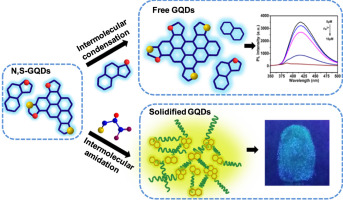Our official English website, www.x-mol.net, welcomes your
feedback! (Note: you will need to create a separate account there.)
Simultaneously fabrication of free and solidified N, S-doped graphene quantum dots via a facile solvent-free synthesis route for fluorescent detection
Talanta ( IF 5.6 ) Pub Date : 2017-03-25 15:42:08
Chang Xia, Xin Hai, Xu-Wei Chen, Jian-Hua Wang
Talanta ( IF 5.6 ) Pub Date : 2017-03-25 15:42:08
Chang Xia, Xin Hai, Xu-Wei Chen, Jian-Hua Wang

|
A facile one-step solvent-free synthesis approach is proposed for the simultaneous fabrication of free and solidified N, S-doped graphene quantum dots (N, S-GQDs) by using citric acid as precursor and L-cysteine as dopant. Graphene nucleus is firstly formed via the intermolecular dehydration of citric acid. N and S are then incorporated into the graphene structure by attacking the margin of graphene nucleus. The cross-linking among the graphene nucleus via the intermolecular condensation leads to the generation of free N, S-GQDs, while the intermolecular amidation between L-cysteine molecules and graphene nucleuses contributes to the solid-state fluorescence graphene quantum dots (SSF-GQDs). The free N, S-GQDs exhibit favorable photoluminescence behaviors such as high fluorescent quantum yield of 74.5%, stable photoluminescence within a wide range of pH and high tolerance to external ionic strength of up to 1.0molL−1 NaCl, making it excellent fluorescence probe for the sensitive detection of Fe3+ with a linear range of 0.01–3μM and a detection limit of 3.3nM. The solidification of GQDs prevents the aggregation of GQDs efficiently and offers the solidified N, S-GQDs yellow-green fluorescence, with a fluorescence quantum yield of 10.6%. This proposed protocol provides a novel avenue to fabricate diverse fluorescent graphene materials for different practical applications.
中文翻译:

通过简便的无溶剂合成路线同时制造用于荧光检测的游离和固化的N,S掺杂的N掺杂石墨烯量子点
提出了一种简便的无溶剂一步法合成方法,该方法以柠檬酸为前体,L-半胱氨酸为掺杂剂,同时制备游离的和固化的N,S掺杂的石墨烯量子点(N,S-GQDs)。石墨烯核首先通过柠檬酸的分子间脱水形成。然后通过攻击石墨烯核的边缘将N和S结合到石墨烯结构中。石墨烯核之间通过分子间缩合的交联导致生成游离的N,S-GQD,而L-半胱氨酸分子与石墨烯核之间的分子间酰胺化作用有助于固态荧光石墨烯量子点(SSF-GQDs )。游离的N,S-GQDs表现出良好的光致发光行为,例如74.5%的高荧光量子产率,-1 NaCl,使其成为灵敏检测Fe 3+的优秀荧光探针,线性范围为0.01–3μM,检测极限为3.3nM。GQD的固化可有效防止GQD聚集,并提供固化的N,S-GQDs黄绿色荧光,荧光量子产率为10.6%。该拟议的协议提供了一种新颖的途径来制造用于不同实际应用的各种荧光石墨烯材料。
更新日期:2017-03-26
中文翻译:

通过简便的无溶剂合成路线同时制造用于荧光检测的游离和固化的N,S掺杂的N掺杂石墨烯量子点
提出了一种简便的无溶剂一步法合成方法,该方法以柠檬酸为前体,L-半胱氨酸为掺杂剂,同时制备游离的和固化的N,S掺杂的石墨烯量子点(N,S-GQDs)。石墨烯核首先通过柠檬酸的分子间脱水形成。然后通过攻击石墨烯核的边缘将N和S结合到石墨烯结构中。石墨烯核之间通过分子间缩合的交联导致生成游离的N,S-GQD,而L-半胱氨酸分子与石墨烯核之间的分子间酰胺化作用有助于固态荧光石墨烯量子点(SSF-GQDs )。游离的N,S-GQDs表现出良好的光致发光行为,例如74.5%的高荧光量子产率,-1 NaCl,使其成为灵敏检测Fe 3+的优秀荧光探针,线性范围为0.01–3μM,检测极限为3.3nM。GQD的固化可有效防止GQD聚集,并提供固化的N,S-GQDs黄绿色荧光,荧光量子产率为10.6%。该拟议的协议提供了一种新颖的途径来制造用于不同实际应用的各种荧光石墨烯材料。




































 京公网安备 11010802027423号
京公网安备 11010802027423号